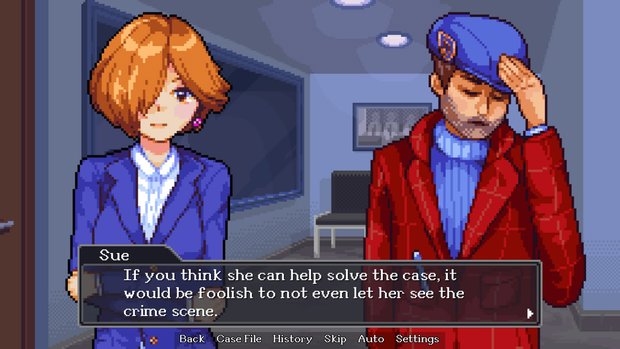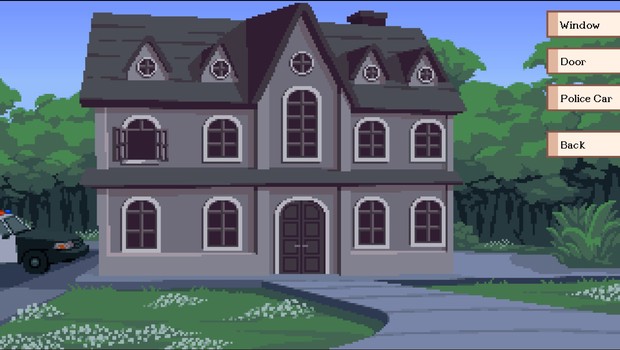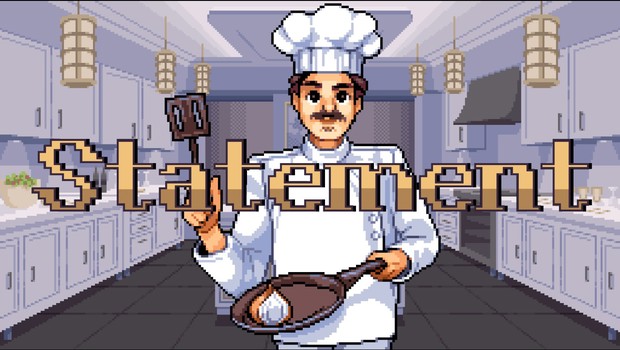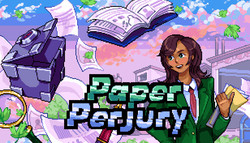Paper Perjury review

- 0 Comments
Modest, charming detective mystery largely aces its honest attempt to imitate its more famous legal predecessor
If imitation is the sincerest form of flattery, then somewhere out there is a certain finger-pointing defense attorney who is surely blushing all the way down to the pixelated roots of his slicked-back hairdo. This is thanks to Paper Cat Games’s Paper Perjury, a homage to Capcom’s seminal courtroom series, and a well-done one at that. While it doesn’t break any particularly new ground, it makes a strong case for being adventure game comfort food, with gameplay that’s nearly identical to its inspirations and a presentation that is immediately gratifying in its easy-on-the-eyes-and-ears retro simplicity, which fans both young and old are sure to dig. It even entirely does away with progression-halting penalties we tend to see in these sorts of games, though it does occasionally stumble on a poorly clued puzzle sequence or two.
Paper Perjury takes place in Azure City, an idyllic and tranquil metropolis. Though the game’s somewhat lighter tone makes the city feel like an inviting place you’d want to spend time in, a police force is nonetheless required to handle the occasional bit of crime. Enter Justina Smith, a young woman starting her first day as the station’s newbie file clerk. Though her job would typically make her an office drone, it doesn’t take long (mere minutes, in fact) before Justina is tasked with assisting one of the station’s detectives with a case, both in the field hunting for clues and gathering testimonies, and in the interrogation room putting the screws to suspects.
If all this sounds very familiar, that’s by design. In terms of the core point-and-click gameplay loop, there is virtually no distinction between Paper Perjury and most other legal visual novel-styled adventures: investigate each static location until all hotspots have been examined and exhaust every dialog option during conversations to gather the necessary clues and evidence needed for the upcoming courtroom (or, in this case, interrogation room) sequence where you untangle the knot and solve the mystery.

With carbon-copy gameplay, then, what sets this game apart is its consistently bright and cheerful atmosphere. Even when squaring off with a tricky ne’er-do-well, there’s something simple and wholesome about the cast of characters and the relationships between them. In particular, Justina’s budding friendships (maybe even more?) with detectives Ernest Hunt and Sophie Swift, the officers with whom she finds herself paired up, are satisfying to watch unfold. Yes, it’s all very sitcom-y, but charming and engaging nonetheless, in a simple, uncomplicated sort of way.
A large part of the charm is due to the inviting presentation. Graphically, the game leans into a decidedly retro aesthetic, with pixel art locations that will particularly please fans of classic point-and-click adventures. It’s a modern metropolitan setting, but it is far from one-note; over the course of the adventure, Justina will need to thoroughly comb through crime scenes ranging from posh mansions to dumpster-filled back alleys, from a former roadside motel run by a budding street magician to a high-rise executive suite lording over the whole city. They’re all done in a color palette that’s generally vivid and cozy, and between sessions I found myself looking forward to my next visit to Azure City.

Character models, displayed in the foreground like any visual novel, are large, with most attired in one particular color or another, giving rise to some, ahem, colorful nicknames. Their designs are somewhat more grounded and less zany than we might have seen in similar games, but car mechanic Megan Kaneki, magician Annie Carde, and personal maid Chandra Lear still hit a sweet spot of punny names and memorable appearances to make them instantly recognizable. The only drawback of the large character models is that their respective pixels also appear proportionally larger, which doesn’t have quite as nice of an effect as the smaller ones evident in the environments, but some animated flourishes easily make up for this, like Justina’s propensity for rolling her eyes when a suspect really gets her goat, or the way Detective Swift will spin her motorcycle helmet on her finger like a basketball.
The soundtrack, too, performs its part in creating an endearing experience. While the graphics recall adventure gaming’s (g)olden days, the musical accompaniment is a bit more modern – no mere chiptunes here. Compositions are catchy and upbeat, with character themes that are generally optimistic and bouncy. Seeing a character pop up out of nowhere as a jaunty tune heralds their arrival always managed to put a smile on my face. Voice acting, however, is entirely absent, apart from differently pitched bleeps and bloops that accompany each character’s on-screen text.
That same sense of good-natured humor applies to the writing as well, though never so sickly sweet that it feels overbearing or out of place. People seem genuinely warm and friendly with each other, and even where conflict needs to exist (for example, between the police officers and the suspects’ defense attorney) it never feels mean-spirited or ill-intentioned. You get the sense that at the end of the workday, the characters will clap each other on the back and head off to a pub to enjoy each other’s company. Even the criminals don’t seem like they’d hold too much of a grudge against Justina after being exposed.
Paper Perjury’s narrative stretches across five cases (with at least one more case due to arrive soon as a free update) comprising about ten to fifteen hours of playtime in total, all of which are accessible immediately from the main menu, though playing them in order is highly recommended. The game’s cast is rather small and intimate, with several individuals becoming mainstays in later cases after being introduced earlier on. This allows for the characters to become more fleshed out, and story arcs to take their time before ultimately being resolved. Even the crimes themselves are somewhat interconnected, mostly revolving around members of the wealthy Eubank family, who run a big local investment firm and may or may not be involved in some shady business practices.

Of course, evil-doers can’t be brought to justice until you’ve gathered evidence against them during the first-person exploration phase. In each chapter, Justina accompanies one of the detectives into the field where a handful of locations – around four or five per case – must be searched and witnesses questioned. The game does away with the need for pixel hunting altogether; each location is accompanied by an on-screen list of pertinent objects that can be examined closer.
Similarly, eyewitness interviews simply involve exhausting each person’s dialog tree, which sometimes leads to discovering new clues that are noted in a menu and act as a sort of inventory during the next phase of the process, though Justina will occasionally need to bust out a piece of hard evidence as well. Once all necessary pieces of information have been gathered, the case moves on to its second and final phase: the interrogation sequences where the culprits must ultimately be brought to justice.
It’s here that Paper Perjury really goes the extra mile to ensure your success. Interrogations follow the familiar method of a suspect making a handful of statements, with Justina able to press them for further elaboration before ultimately presenting a piece of evidence that directly contradicts one of their statements. This is usually not too difficult: lies or inconsistencies aren’t often hard to suss out, and the game keeps track of which pieces of evidence you’ve already attempted to present by crossing wrong choices off the evidence list (though this resets to a clear slate after each step in the interrogation sequence).
Finally, and most importantly, there is absolutely no way to lose or get a fail state. Penalties for picking an incorrect piece of evidence have been left out entirely, and there’s no limit to how many times you can restart an interrogation from the top. It can be tempting, then, albeit tedious and unsatisfying, to just pick options from the list until one eventually works to brute-force the puzzle, removing the need for player skill. Truth be told, though, I was glad for this feature at least a couple of times, as the occasional piece of evidence was just too ambiguous in its description and intended use, and there were three or four times throughout the playthrough where I honestly did not understand what inconsistency I was supposed to zero in on.
Final Verdict
A few imprecise moments like these notwithstanding, Paper Perjury is still a good time overall, very much content to not reinvent any part of the courtroom visual novel wheel but ably covering all the ground it needs to. Younger gamers or newcomers to the genre will be happy about its “never fail” philosophy, but even more important is the warm and friendly atmosphere the game exudes. Between its likeable cast of characters, charming graphics, and upbeat music, I was always up for another visit to Azure City to knock its criminal masterminds down a peg or two. It’s a modest but enjoyable outing that should scratch that itch for anyone waiting for a certain ace attorney’s next case, while giving us a newcomer on the legal scene to root for in future installments.
Hot take
Paper Perjury doesn’t fall far from the Phoenix Wright tree, but that’s absolutely part of its appeal. Content to give a familiar formula its own distinctly breezy atmosphere, the game’s occasional nebulous solutions are ultimately made up for by a charming presentation and endearing cast of characters.
Pros
- Colorful, inviting retro pixel art
- Cozy writing with a likeable cast of characters
- Newcomer-friendly with no penalties or pixel hunting
Cons
- A few unclear interrogation puzzles may require tedious brute-forcing to proceed
Pascal played Paper Perjury on PC using a review code provided by the game's publisher.











0 Comments
Want to join the discussion? Leave a comment as guest, sign in or register in our forums.
Leave a comment